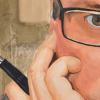Search the Community
Showing results for tags 'feeders'.
-
I have often read that the difference between Pelikan 400 feeders and 140 ones is their length. Even, I think that I have heard that some people say that the 140 nib collars are a bit narrower also. I assumed that until I found the following feeder-nib unit mounted on a model 400. First I thought it was a Frankenpen but I disassembled the unit and began to make comparisons. You may see it between a model 400 nib unit and a model 140 one. It is also surprising that they all have different protrusions. http://s15.postimg.org/t07bu7iyj/w_IMG_3468t.jpg I also asked about it to some forum mates like Ondina, Pomperopero and Javierba (thanks friends). Apart from those morphological differences, everybody agreed to consider that the two feeders on the left correspond to 400 ones and the two on the right to 140 ones. As something didn’t fit, considering all the opinions and comparing with more feeders, I kept racking my brain until I arrived to the following conclusions: Apart from their common major characteristics, as they are four fins on the backside and one ink channel on the front, several morphological differences can be found between Pelikan 400/140 feeders apart from size. It could be explained because of handmade technology and the three different workshops that Pelikan got prior to 70s, between Germany and Switzerland (as Ondina suggested). Nib collar diameters seem almost identical in both models, that would explain (and favor) 140 feeders misuses in 400 pens. The opposite it is not possible because of the longer dimension of the 400 feeders. In fact, model 400 feeders’ length was USUALLY longer than model 140 feeders to fit longer 400 nibs. But here is the most amazing thing (at least for me). Just as Pelikan 400 fountain pens can be used with 140 nib units, shorter than 400 ones, I state that the short third feeder on the left is a native model 400 feeder.Let’s explain it with the following picture: http://s15.postimg.org/6qy01ecvv/w_1080163t.jpg The key is not wherever the feeder reaches to, but where does the nib should do. Red arrows show where do the nibs have to reach, and as a consequence, where does the other notches are situated (marked with white arrows). Hence, the feeder on the center is from a model 400, though it has the same length of the one on the right (from a 140) because if we set on top a 140 nib, it would lie over a hollow zone. Therefore, what should be checked about a Pelikan 400 feeder it is not its whole length, but the space up to where the red arrow is. If it is hidden by the nib collar, it is enough to check side notches position (indicated by the white arrows) So, in the last picture, the first four feeders from the left would correspond to model 400 and the two on the right to model 140. http://s15.postimg.org/uta8ij457/w_1080159t.jpg I hope this would help you to identify correctly mounted vintage 400 models of those wonderful Pelikans.

